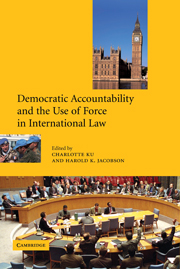Book contents
- Frontmatter
- Contents
- List of figures
- List of tables
- Notes on contributors
- Preface
- List of abbreviations
- I Introduction
- II The domestic and international context
- III Traditional contributors to international military operations
- IV Newcomers to international military operations
- V Permanent members of the UN Security Council
- VI Conclusion
- 15 Toward a mixed system of democratic accountability
- Appendix A. Uses of military forces under the auspices of the UN and NATO
- Appendix B. Country participation in international operations, 1945–2000
- References
- Index
15 - Toward a mixed system of democratic accountability
Published online by Cambridge University Press: 30 July 2009
- Frontmatter
- Contents
- List of figures
- List of tables
- Notes on contributors
- Preface
- List of abbreviations
- I Introduction
- II The domestic and international context
- III Traditional contributors to international military operations
- IV Newcomers to international military operations
- V Permanent members of the UN Security Council
- VI Conclusion
- 15 Toward a mixed system of democratic accountability
- Appendix A. Uses of military forces under the auspices of the UN and NATO
- Appendix B. Country participation in international operations, 1945–2000
- References
- Index
Summary
Two fundamental trends characterized political developments in the twentieth century. One was the growth in the number and authority of international institutions. As part of this trend, states agreed that international institutions should be given the capacity to authorize the use of military forces for collective purposes. The other trend was democratization: the broad acceptance of basic concepts of human rights, the deepening of democracy in countries that had democratic characteristics at the beginning of the century, and the growth in the number of democracies. As the preceding chapters demonstrate, these two trends intersect.
Robert A. Dahl ended his book On Democracy by identifying a number of challenges to democracy. One of these was internationalization. Dahl wrote: “from a democratic perspective, the challenge posed by internationalization is to make sure that the costs to democracy are fully taken into account when decisions are shifted to international levels, and to strengthen the means for holding political and bureaucratic elites accountable for their decisions.”
This challenge is particularly acute in the important area of the use of military forces. Outlawing their unilateral and unrestrained use was an important success of the first half of the twentieth century, finally achieved with the United Nations Charter in 1945. After the Second World War, states largely came to accept the norm that the unilateral use of military force against the territorial integrity of another state violated international law and could legitimately be opposed by a collective response of the international community.
- Type
- Chapter
- Information
- Publisher: Cambridge University PressPrint publication year: 2003

